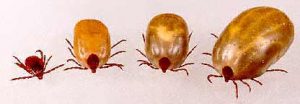You may have seen the news headlines recently stating that nearly 1 in 3 dogs visiting vets last summer were found to be carrying at least one tick. This stat is taken from the results of a large research study undertaken last year called “The Big Tick Project”. Hope Vets contributed to this project and it may be that we sent in one of your very own dogs’ ticks!
So what are ticks and why should we care?
Pretty gross eh? This is a typical tick that we might find on dogs. They start off tiny and as they feed they get bigger and bigger. Because they numb the area of skin that they have attached to, the dog won’t necessarily bother at the area.
Ticks (quite apart from looking like foul alien invaders) are important because they can cause local skin reactions but much more importantly because they can transmit other diseases. Tick-borne disease is prevalent in the rest of Europe but up to now we have been less affected and the only disease an English tick was able to give you or your dog was Lymes disease (which can be really serious and difficult to treat). More recently ticks have been found in the UK carrying a parasite called Babesia which can give dogs severe anaemia.
Don’t panic…..
Well it isn’t all bad news. Although there is no question that ticks are an increasing problem in the UK, the good news is that they are visible and feel-able. If you check your dogs carefully after walks you will find them. More good news is that in our little corner of the world, although in the study we are rated 4/5 in terms of risk of ticks, Hope Vets patients still are only rarely effected by ticks. We don’t seem to have large populations of ticks in our immediate area but be warned, we have definitely seen more this year than previously and if the rest of the country is anything to go by, ticks are on the up.
What should we do to protect our dogs?
If you have seen ticks on your dogs previously or if you are travelling to areas with a high risk of ticks then we recommend adding tick control to your parasite regime. There are lots of products you can use. Some repel ticks and kill them and others just kill them. All the products we recommend for ticks kill them within 24 hours, this is important as the tick-borne diseases are only usually transmitted after the tick has been feeding more than 24 hours.
It is really important to check your dogs for ticks after a walk by feeling through all areas of their coat. You will feel a little lump which if you then look closely has a little mouth and legs. If you find a tick it is important not to pull them out. The mouthparts are corkscrew-like so you need to twist them anti-clockwise to ensure you don’t leave the head embedded in your dog’s skin. We stock little plastic tick twisters to help you, but if you are worried about doing it yourself we can remove the ticks for you.
If you would like more information:
• Full access to the Big Tick Project research paper


